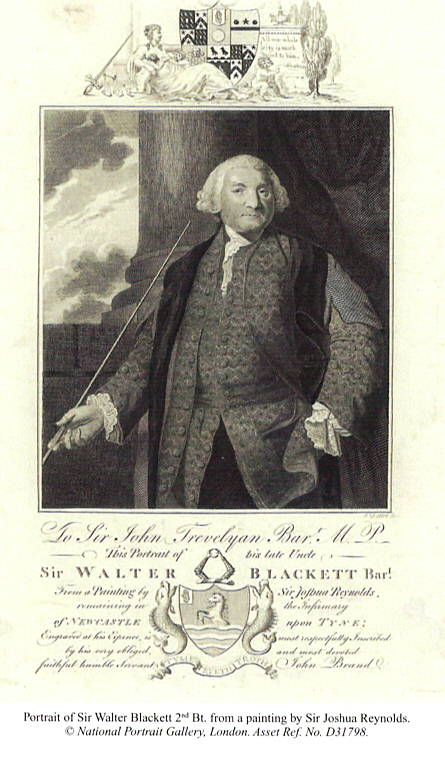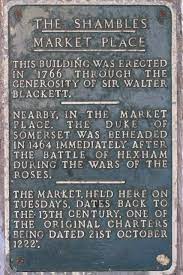
Sir Walter Blackett (1707-1777) was MP for Newcastle between 1734 and 1777. He had inherited the vast Blackett estates and mining interests through his marriage to Elizabeth Orde, the illegitimate daughter of his uncle, Sir William Blackett of Newcastle (2nd Baronet) and had changed his name from Calverley to Blackett in accordance with the terms of Sir William's Will.
He was also a man of noted benevolent and philanthropic qualities and was well known for his generosity and public spiritedness at both a personal and public level.
For these and other qualities he acquired a number of nicknames including “the King Of Newcastle”, “the Patriot” and as an independant man “the Opposer Of The Court” and was made an alderman and freeman of Newcastle, and mayor on no less than five occasions in 1735, 1748, 1754, 1756 and 1771.
His charitable acts were well known and many personal acts included paying for the building in 1736 of Thomlinson's Library at St.Nicholas’s church, Newcastle for public use and to house books bequeathed to the Corporation Of Newcastle. The building was described as “a handsome fabric, consisting of two storeys” to which Sir Walter endowed an annual rent charge of twenty five pounds to support its upkeep.
Sir Walter was also one of the great benefactors of Newcastle Infirmary and gave two hundred pounds towards its construction in 1751 with an annual endowment of fifty pounds. In 1754 he deposited with the Mayor and Burgesses of Newcastle twelve hundred pounds for the provision of a hospital to care for “six poor and decayed burgesses”. He also funded a fifty pound contribution towards the rebuilding of the church at St. John’s Chapel in Weardale, built the market hall in the market square in Hexham in 1766, and the greater part of St. Michael and All Angels Church in Warden, Northumberland in 1764.

So popular he seems to have been that on 17 October 1767, when laying the first stone of the bridge at the river at Hexham Abbey, in the presence of thousands of spectators, and amidst much entertainment, the streets reputedly rang out with “success to the bridge of Hexham” and “long live Sir Walter Blackett”
Not all gestures seem to have been so public or grand; one anecdote relates to an incident in Weardale when Sir Walter was hunting and
“happened to arrive at the cottage of a poor shepherd,
Who, though unknown to him, was one of his tenants.
To a visitor of Sir Walter’s appearance, the poor cottager
brought out the best his
frugal board could produce. During his stay, Sir
Walter enquired to whom the house belonged ? " To
one of the best men in the world," said the cottager;
“to Sir Walter Blackett, sir; no doubt you have
heard of him ; but these knavish stewards for these
three years past have advanced my rent to almost
double the value of the little tenement I occupy. I
wish I could have the honour to see my worthy land-
lord, I would acquaint him with my ill usage.” Sir
Walter smiled, but did not discover himself. On
departing, he presented the cottager’s wife with a sum
of money, and soon after ordered the house to be
rebuilt, and a considerable abatement to be made.”
Sir Walter was not without a sense of humour, and when a portrait he had commissioned from Sir Joshua Reynolds started to deteriorate, due to Reynolds’s use of unstable materials, he wrote the following lines:
“Painting of old was surely well designed
To keep the features of the dead in mind,
But this great rascal has reversed the plan,
And made his picture die before the man.”
Apparently it was not unique for some of Reynolds’s portraits to fade or crack long before the people depicted in them had passed away.
A slightly more modest act of philanthropy was made by Sir William Blackett (5th Bt.), who in the 12 months to 1 April 1815 donated a total of eleven pounds and one shilling to the Shoreditch Refuge for the Destitute. One of the stated aims of the refuge was to provide temporary relief to distressed persons “and thereby to put an end to the plea of necessity urged by many of the idle, disorderly and profligate characters that infest our streets”.
Modest though the donation was, it was still sufficient to qualify Sir William as a Governor for Life, though he was not able to enjoy the position for long, as he died in 1816.
On a grander scale, Sir William Blackett (1657-1705) established a charity which still flourishes to this day. In his will, he left £1,000 which was to be invested with the income being divided in three. The first third was to fund a school in Newcastle to teach reading. The second third was to be used to fund seven-year apprenticeships in the city. The final third was to be used to alleviate poverty in the parish of St. Andrews.
The Sir William Blackett Charity still maintains a presence in Newcastle. Supported by the income of its historic investments, the charity has assets in excess of £3 million. These investments provide an income of over £200,000 per annum which is reinvested back into St. Andrews Church community.
